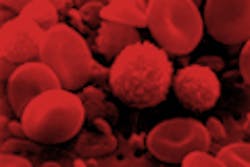Expediting PCR assay development to screen blood donations
Following outbreaks in Brazil in 2015, the Zika virus (ZIKV) spread rapidly across the Americas, with more than 700 confirmed cases in Puerto Rico by March 2016. In February 2016, the World Health Organization declared a Public Health Emergency of International Concern, with 33 countries reporting infections. Concurrently, the U.S. Food and Drug Administration (FDA) issued a Guidance1 prohibiting blood transfusion using blood collected in ZIKV-active areas, including Puerto Rico, without prior screening with a nucleic acid test (NAT) or treatment using pathogen reduction technology (PRT). Since no FDA-approved ZIKV NAT assay was available at the time and use of PRT is limited to plasma and platelet products (i.e., not applicable to red blood cells), blood collection in Puerto Rico was halted, and Puerto Rico was forced to import blood from U.S. states. The FDA then called upon the diagnostics industry to determine the feasibility and timeline for a ZIKV NAT, initially for use with donations collected in Puerto Rico. Roche’s response to the request led to the deployment of an investigational polymerase chain reaction (PCR) assay six weeks after the FDA issued its Guidance and 10 weeks after assay development was initiated, and, eventually, the first FDA-licensed test for screening ZIKV in blood donations about 18 months later. Achieving these milestones required a streamlined process and resulted in knowledge that may guide rapid response to emerging infections in the future.
Accelerating assay development
An in silico process, in combination with a proprietary assay design software tool, expedited the screening of the genome sequence of ZIKV to select the best candidate probes and primers for a reverse-transcriptase PCR assay. These candidates were then evaluated in the laboratory with proprietary enzymes and chemistries. The optimal design was rapidly developed into a fully automated screening test with ready-to-use reagents on high-throughput blood screening platforms. Round-the-clock reagent and software development activities took place in two locations several time zones apart (Pleasanton, California, and Rotkreuz, Switzerland); with careful planning, this allowed the team to leverage the time difference to create the equivalent of two workdays from each calendar day. The verified assay design was then transferred to Operations for Good Manufacturing Processes (GMP)-compliant manufacture.
Expediting the clinical study
The investigational Zika test was to be deployed for use in a clinical study under an Investigational New Drug (IND) application. Thus, concurrent with assay development and performance verification, researchers began working through the many steps involved in initiating a clinical study. These included developing the study protocol, drafting donor information and consent materials in English and Spanish, submitting the protocol for institutional review board (IRB) approval, planning training of collection site staff and lab personnel, installing the PCR systems at testing laboratories, and addressing logistics such as contracting with collection sites, reagent kit design, and database creation—all in parallel, in contrast to a more traditional linear process.
Just as significant in this extraordinary race were the frequent communications with regulatory and public health agencies, notably the FDA and the Centers for Disease Control and Prevention (CDC). Real-time communications (e.g., presenting data or proposed plans for review), with an eye toward the common goal, enabled the scientists to expedite the process without compromising checks and balances. In the end, assay performance was assessed based on criteria established with FDA input, including specificity, sensitivity, limit of detection, cross-reactivity, matrix equivalency, and evaluation of potential interfering substances.
The outcome
On March 30, 2016, the FDA granted approval for the use of the test under IND authorization, enabling blood centers to use or discard a blood donation based on test results showing the absence or presence of ZIKV in the donor specimen. In Puerto Rico, collection of blood donations resumed three days later, less than four weeks after collection halted as a result of the FDA guidance to screen donations for ZIKV. The FDA required ZIKV screening of blood donations to be performed as individual donation testing (IDT) and did not authorize testing in minipools (e.g., pools of six donations).
Soon after screening with the test was implemented for Puerto Rico donations, screening blood donations for ZIKV was implemented voluntarily at blood banks in several U.S. states. Some ZIKV RNA-positive donations were detected at these blood banks before ZIKV screening became mandatory.
After the test received IND approval, the FDA asked for data on the number of donations screened at each location, and both the FDA and the CDC received immediate notification of any ZIKV-reactive samples. In addtion, a weekly data summary was sent to both agencies, as well as AABB, some state public health directors, and the study principal investigators. These reports provided the necessary real-time data to the FDA to help direct its response for blood safety and to the CDC to support surveillance and vector control efforts.1 Similarly, scientists were able to mine the study data to deepen their understanding of ZIKV. For example, one study pinpointed ZIKV risk factors such as travel more than four weeks before donation and sexual exposure.2 Another used it in a comparative study of ZIKV NATs.3
On August 26, 2016, the FDA revised its Guidance4 to mandate that, within 12 weeks, all U.S. donations, not just those in areas designated as ZIKV-active, be screened with NAT or treated with PRT. This included donations collected in U.S. territories besides Puerto Rico and at U.S military facilities around the world. The clinical study team worked closely with testing laboratories and collection sites to enroll them quickly in the clinical study and to expand testing capacity rapidly to meet the revised FDA requirements. Within 12 weeks, the number of testing laboratories participating in the IND study increased from four to 13 and the number of donations screened with the investigational assay increased from less than 10,000 to more than 80,000 in a typical week. Weekly data summaries continued to be provided to the FDA, the CDC, and others involved in the ZIKV response through November 2017.
The Biologics License Application (BLA) for the Zika test was submitted to the FDA in April 2017. On October 5, 2017, the FDA announced licensure of the test for the detection of ZIKV RNA in plasma samples from volunteer blood donors and living organ and tissue donors. The announcement noted the importance of working “rapidly and collaboratively with the FDA and the blood collection industry to respond to a public health crisis.” Between the initiation of screening and licensure, more than 4.3 million donations had been screened using the test in 13 laboratories serving about 150 collection sites. Most important, screening during this period identified 356 infected donations from Puerto Rico and 29 infected donations collected in U.S. states and excluded them from the blood supply, potentially preventing more than 1,000 recipients from exposure to the virus. (Whole blood donations are typically separated into three components—packed red blood cells, platelets, and plasma—and ZIKV screening included samples from donors of whole blood, platelets, and plasma.) Most confirmed ZIKV-positive donations detected in U.S. states were collected from donors who reported recent travel to ZIKV-active areas, including Caribbean islands, Mexico, and the Philippines.
While the incidence of ZIKV may be subsiding in many areas—the last confirmed positive donation from Puerto Rico was detected in late May 2017—ZIKV-reactive donations continue to be identified from donors in U.S. states. The most recent confirmed ZIKV-positive donation was collected on October 4, 2017, in the Houston, TX, area from a donor who reported recent travel to central Mexico. Thus, blood screening for ZIKV is expected to continue in the foreseeable future.
One option being considered is a switch from IDT to minipool screening, in which donations are screened in small pools (e.g., composed of aliquots from six donor samples), followed by individual testing of constituents of reactive pools, perhaps in areas where ZIKV is not known to be present or during times of the year when mosquitoes are not active, and possibly in conjunction with pre-donation questions intended to determine a donor’s potential ZIKV risk from travel. Such a strategy is currently used for West Nile virus (WNV), in which screening can occur in minipools until WNV is present in collection areas. This strategy, however, may not be a perfect fit because the ZIKV viral loads for confirmed ZIKV-positive donations collected in U.S. states tend to be low, so minipool testing would be likely to miss many of these donations.
A possible model for emerging infections
Recent outbreaks of chikungunya virus and dengue virus outside of the U.S. and the presence in several U.S. states of Babesia microti and B. duncani, a tick-borne intraerythrocytic parasite, highlight the ongoing public health threat of emerging infections. Similar to the rapid spread of ZIKV through the Americas, emerging infections are unexpected and require rapid response. While it is not feasible to develop laboratory tests for all pathogens in the absence of market demand, a commitment to preparedness for emerging infections is an important step in protecting patients. The accelerated development process for the Zika screening assay confirmed the importance of quick action by the FDA to protect the blood supply, extensive communication between assay developers and the FDA, clearly defined goals, and effective collaboration among laboratories, collection centers, clinical investigators, and test developeer personnel to rapidly deploy a test and quickly bring to market a solution to address a public health emergency.
REFERENCES
- Chevalier MS, Biggerstaff BJ, Basavaraju SV, et al. Use of blood donor screening data to estimate Zika virus incidence, Puerto Rico, April-August 2016. Emerg Infect Dis. 2017;23(5). doi: 10.3201/eid2305.161873. PMID 28263141.
- Galel SA, Williamson PC, Busch MP, et al. First Zika-positive donations in the continental United States. Transfusion. 2017;57(3pt2):762-769. doi: 10.1111/trf.14029.
- Stone M, Lanteri MC, Bakkour S, et al. Relative analytical sensitivity of donor nucleic acid amplification technology screening and diagnostic real-time polymerase chain reaction assays for detection of Zika virus RNA. Transfusion. 2017;57(3pt2):734-747. doi: 10.1111/trf.14031.
- U.S. Food and Drug Administration. Guidance for industry: revised recommendations for reducing the risk of Zika virus transmission by blood and blood components (August 2016). Silver Spring (MD): CBER Office of Communication, Outreach, and Development; 2016.
Lisa Lee Pate, MD, JD, serves as Director, Clinical Science for Blood Screening, for Roche Molecular Systems, Inc.

